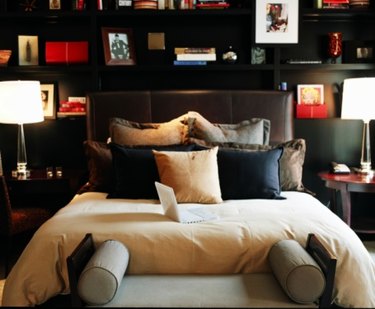
While the bedroom is often one of the last rooms in the house to receive a makeover, design traditions are still debated there. There are those who believe that a bed is not truly complete without a proper headboard and footboard, and others who simply don't see the point or care for the look. Like every other design decision, there are pros and cons to installing a footboard on a bed.
Pro: Traditional Finish
Video of the Day
The installation of a headboard and footboard gives a bed a traditional finish. There are no trends bucked by omitting the footboard, and the room immediately assumes a more conventional look.
Video of the Day
Pro: Neatness
A footboard can hide the imperfections of a hastily made bed and helps to hold a comforter in place.
Pro: Decorative Opportunity
If one is so inclined, the rails of a footboard can easily be used as a decorative element. A breezy summer hat can be hung on a rail, or a fun and funky necklace collection suspended from it.
Pro: Secures Mattress
For all practical purposes, it is the footboard that prevents the mattress from slipping down from the box springs. The fact that it keeps everything where it belongs adds to the overall neatness of the room.
Con: Injury
Tall or active sleepers can easily stub a toe in their sleep. Another potential toe-stubbing injury can occur while moving around the footboard to make the bed or while returning to bed after a nocturnal bathroom break.
Con: Hides Bedspread
If you have bedding that you find particularly attractive you may not want a footboard in the way, blocking its full decorative glory. In addition, it can be very difficult to position a bed skirt or bedspread properly when footboard rails are in the way.
Con: Old-Fashioned
A footboard can be old-fashioned, even fussy looking. A more modern decor often depends upon a simpler design scheme. Omitting a footboard gives you a clear space to add another piece, such as a bench or attractive trunk.